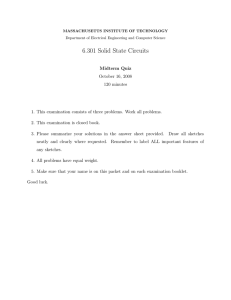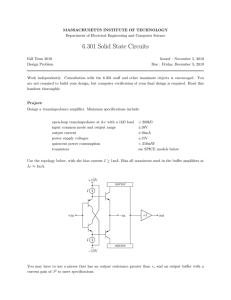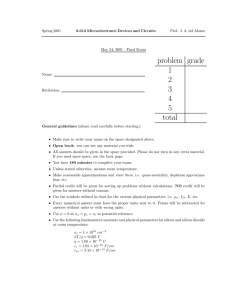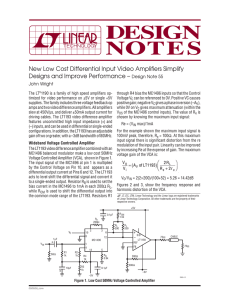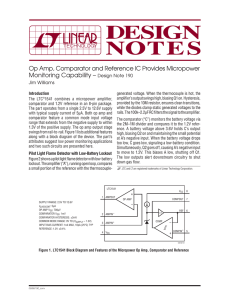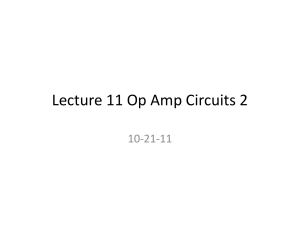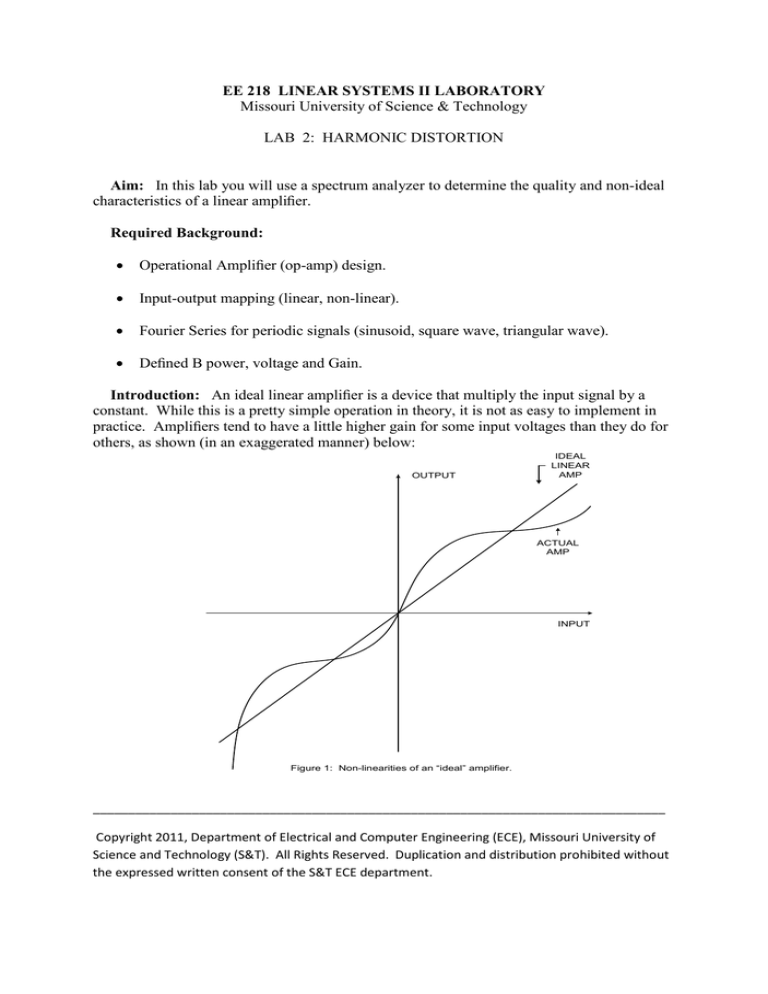
EE 218 LINEAR SYSTEMS II LABORATORY
Missouri University of Science & Technology
LAB 2: HARMONIC DISTORTION
Aim: In this lab you will use a spectrum analyzer to determine the quality and non-ideal
characteristics of a linear amplifier.
Required Background:
•
Operational Amplifier (op-amp) design.
•
Input-output mapping (linear, non-linear).
•
Fourier Series for periodic signals (sinusoid, square wave, triangular wave).
•
Defined B power, voltage and Gain.
Introduction: An ideal linear amplifier is a device that multiply the input signal by a
constant. While this is a pretty simple operation in theory, it is not as easy to implement in
practice. Amplifiers tend to have a little higher gain for some input voltages than they do for
others, as shown (in an exaggerated manner) below:
OUTPUT
IDEAL
LINEAR
AMP
ACTUAL
AMP
INPUT
Figure 1: Non-linearities of an “ideal” amplifier.
_________________________________________________________________________________
Copyright 2011, Department of Electrical and Computer Engineering (ECE), Missouri University of
Science and Technology (S&T). All Rights Reserved. Duplication and distribution prohibited without
the expressed written consent of the S&T ECE department.
This non-linear distortion means if you put a sine wave into the amplifier, the output will
not look exactly sinusoidal. Since the output is not a sine wave, it will have power at
frequencies where the input signal had no power. If I put a sine wave of 1 kHz into the
amplifier, the output signal will still be a periodic signal with a fundamental frequency of 1
kHz, but it may have energy at multiples, or harmonics, of 1 kHz (namely 2 kHz, 3 kHz, 4
kHz, etc.). If the signal is a voice or musical instrument, the pitch (note) of the output signal
1 will be the same as the input signal, but the tone (timber) will be different. In other words,
the input signal might sound like a flute playing middle C, while the output sounds more like
a clarinet playing the same note. Because the distortion is at harmonic frequencies of the
input, this type of distortion is called ’harmonic distortion’. One usually measures the power
in the unwanted harmonics, and divides it by the total power in the output signal to arrive at a
term known as THD, or Total Harmonic Distortion (written in percent). The unwanted
harmonics are also called ’spurious emissions’ or ’spurs’ for short. Sometimes people
specify the quality of an amplifier or signal source by saying things like ’the spurs are down
60 dB’, meaning the most powerful harmonic is 60 dB weaker than the signal at the desired
frequency.
The drawing above exaggerates the size of the nonlinearity for most amplifiers. You could
try to measure the nonlinearity by putting in voltages of different levels and measuring the
voltage on the output. Since most non linearities are very slight, you will have to have a very
high quality volt meter to make the measurements meaningful. This problem is compounded
because many volt meters are not truly linear either. Another problem with this approach is
that many amplifiers do not pass DC. A better way to measure this nonlinearity is to put a
sine wave into the amplifier, and measure the power in the harmonics in the output.
Procedure: On a prototype/bread board, build an amplifier with a power gain of 6 dB
using an inexpensive op-amp and a negative-feedback design. If you can, match the input
impedance of the amplifier to the output impedance of the function generator. Perform the
following measurements:
1. Check the DC voltage gain of the amplifier using a DC power supply and a volt meter.
2. Check the gain of the amplifier using a 5 kHz tone and an oscilloscope.
3. Check the frequency range of the amplifier by changing the frequency of the input tone,
and watching the display on the oscilloscope connected to the amplifier output. What range
of frequencies can your amplifier amplify and have the gain stay with 20% of the ideal value?
4. Check the range of frequencies you can amplify by connecting the spectrum analyzer to
the amplifier output. Now you should look for the range of frequencies where the output
signal is within 3 dB of the ideal value. This is called the 3 dB bandwidth of the amplifier.
5. Go back to using a 5 kHz tone for an input signal. Measure the total harmonic
distortion at the output for a few different amplitudes on the input. Find the range of input
amplitudes you can use while keeping the THD below 0.1%, 1% and 10%.
_________________________________________________________________________________
Copyright 2011, Department of Electrical and Computer Engineering (ECE), Missouri University of
Science and Technology (S&T). All Rights Reserved. Duplication and distribution prohibited without
the expressed written consent of the S&T ECE department.
6. Does the THD change with the frequency of the input signal?
7. Does the THD change with the gain of the amplifier?
8. You may have noticed that it is a bit of a pain to measure THD using a spectrum
analyzer because there are a lot of harmonics to check. Pass your signal to the sound card of
the PC, digitize it, and see if you can write a Matlab script that will automatically calculate
the THD of the input signal. If possible, have the Matlab script automatically figure out the
frequency of the input signal too.
For Your Writeup:
•
Make sure you clearly show the amplifier circuit and how you calculated the feedback
network to obtain a power gain of 6 dB.
•
Part 1-2: Use a percent difference calculation to show that your measured gains are
close to the theoretical gain.
•
Part 5: It may be difficult to find the exact amplitude where you cross one of the THD
thresholds (i.e. 0.1%, 1%, or 10%). However, if you plot the THD as a function of
input amplitude, you should be able to interpolate when these THD values will occur.
•
Part 6-7: This is not just a yes/no answer. You must have data to support your answer.
_________________________________________________________________________________
Copyright 2011, Department of Electrical and Computer Engineering (ECE), Missouri University of
Science and Technology (S&T). All Rights Reserved. Duplication and distribution prohibited without
the expressed written consent of the S&T ECE department.

